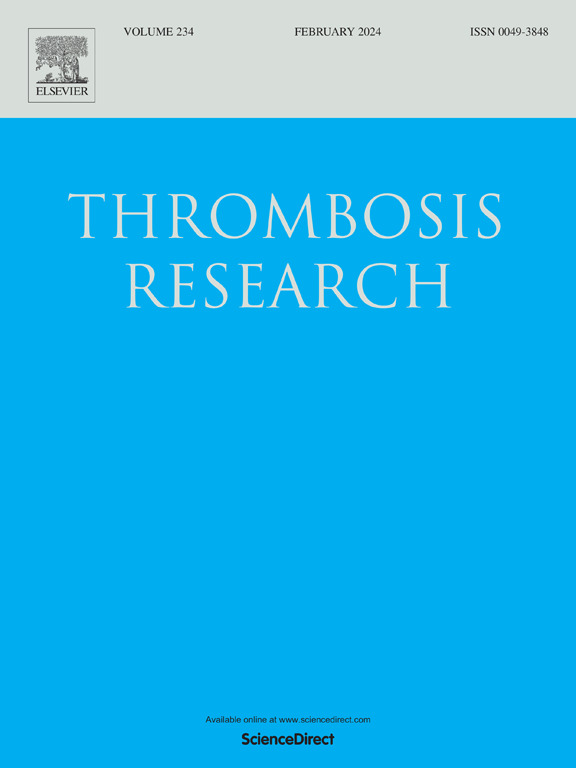Letter-To-The-Editor: Long-term outcomes of patients with isolated subsegmental pulmonary embolism managed without anticoagulant therapy
IF 3.7
3区 医学
Q1 HEMATOLOGY
引用次数: 0
Abstract
Introduction
The management of patients with subsegmental pulmonary embolism (SSPE) is controversial. The long-term risk of recurrent venous thromboembolism (VTE) in patients with SSPE managed without anticoagulation is unknown. We sought to establish the long-term incidence of recurrent VTE and clinically relevant bleeding complications in this patient population.
Methods
We performed a retrospective cohort study of patients enrolled in the SSPE prospective management cohort study included at The Ottawa Hospital between 2011 and 2021. The outcomes included major recurrent VTE (proximal deep vein thrombosis or pulmonary embolism) and clinically relevant bleeding (major + clinically relevant non-major bleeding). Incidence rates along with their 95 % confidence intervals (CI) for the primary and secondary outcome measures were computed by performing time-to-event analyses.
Results
A total of 138 patients with SSPE were included in the analysis. Mean age was 57 ± 15.5 years and 50.7 % were female. Median follow-up period was 69 months (IQR: 44–96 months). Overall, recurrent major VTE occurred in 15 out of the 138 patients leading to an incidence of 1.9 per 100 patient-years (95 % CI: 1.2–3.2). Clinically relevant bleeding was reported in 15 patients corresponding to a cumulative incidence of 1.9 per 100 patient-years (95 % CI: 1.1–3.1). Of these, 3 patients experienced major bleeding.
Conclusion
The long-term incidence of VTE is relatively low in patients with isolated SSPE managed without anticoagulation. Future studies are needed to assess the risk benefit ratio of anticoagulation in this patient population.
致编辑信:孤立性亚节段性肺栓塞患者未经抗凝治疗的长期预后
亚节段性肺栓塞(SSPE)患者的治疗存在争议。不进行抗凝治疗的SSPE患者复发静脉血栓栓塞(VTE)的长期风险尚不清楚。我们试图确定在该患者群体中复发性静脉血栓栓塞和临床相关出血并发症的长期发生率。方法:我们对渥太华医院2011年至2021年间纳入SSPE前瞻性管理队列研究的患者进行了回顾性队列研究。结果包括严重复发性静脉血栓栓塞(近端深静脉血栓形成或肺栓塞)和临床相关出血(严重出血+临床相关非严重出血)。发生率及其95%可信区间(CI)的主要和次要结果测量通过执行时间到事件分析计算。结果共纳入138例SSPE患者。平均年龄57±15.5岁,女性占50.7%。中位随访69个月(IQR: 44-96个月)。总体而言,138例患者中有15例发生复发性静脉血栓栓塞,发生率为每100例患者年1.9例(95% CI: 1.2-3.2)。15例患者报告了临床相关出血,累计发生率为1.9 / 100患者-年(95% CI: 1.1-3.1)。其中3例出现大出血。结论孤立性SSPE不进行抗凝治疗的长期静脉血栓栓塞发生率较低。需要进一步的研究来评估抗凝治疗在这一患者群体中的风险收益比。
本文章由计算机程序翻译,如有差异,请以英文原文为准。
求助全文
约1分钟内获得全文
求助全文
来源期刊

Thrombosis research
医学-外周血管病
CiteScore
14.60
自引率
4.00%
发文量
364
审稿时长
31 days
期刊介绍:
Thrombosis Research is an international journal dedicated to the swift dissemination of new information on thrombosis, hemostasis, and vascular biology, aimed at advancing both science and clinical care. The journal publishes peer-reviewed original research, reviews, editorials, opinions, and critiques, covering both basic and clinical studies. Priority is given to research that promises novel approaches in the diagnosis, therapy, prognosis, and prevention of thrombotic and hemorrhagic diseases.
 求助内容:
求助内容: 应助结果提醒方式:
应助结果提醒方式:


